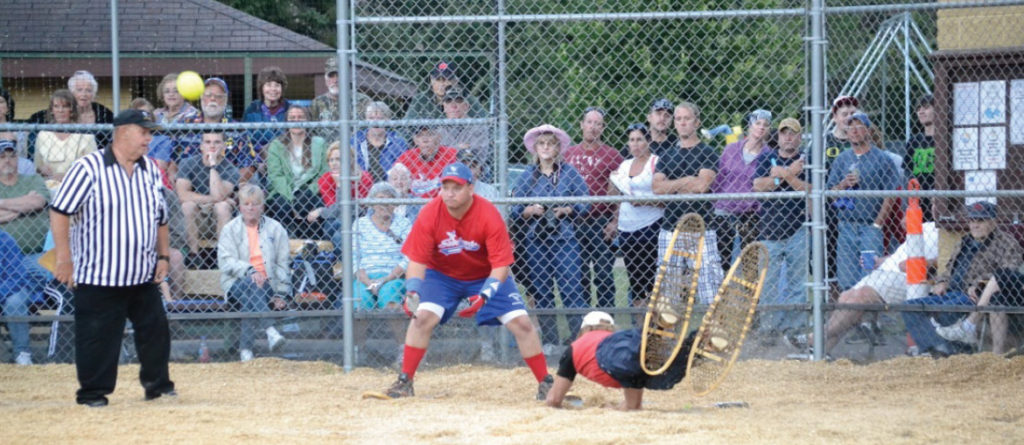When 1,200 people show up for a Monday night ball game, it’s noticeable in a town of 1,100. In July and August, it happens weekly in Lake Tomahawk, turning the streets and local ball park into a scene by Norman Rockwell. There’s no admission fee, not much tailgating and no high stakes riding on the outcome. No ESPN coverage, either (yet).
So what’s the big deal? It depends on whom you ask. Some will tell you it’s the snowshoes. Others will say it’s the pies. In days gone by, it might even have been the skydiving.
It’s a tradition with a rich history. The Lake Tomahawk Snowhawks played snowshoe baseball on snow in the 1940s and ’50s, and even won a world championship. In 1961, at the urging of then-town chairman Ray Sloan, the team began playing on a field of woodchips and sawdust to amuse summer tourists. A tradition was born and Lake Tomahawk claimed its fame as “The Snowshoe Baseball Capital of the World.”
In the late 1970s, the Snowhawks invited paratrooper Chuck Yost to skydive into the park as an added attraction. For years, with his brother Butch piloting their small plane, Yost would drop in at the games, landing unerringly at second base. Although it’s been decades since fans have seen a skydiver, the weekly games are still a magnet for locals and tourists alike.
Families crowd the streets, people greet one another like old friends, and the festive air is palpable. Starting early in the morning — or even the night before — fans reserve their seats by laying blankets on the bleachers (capacity: 800-900), or positioning chairs at the edge of Snowshoe Park.
In the minutes before the game begins, fans crowd around the players for a friendly autograph session. At 7:30 sharp, it’s game time. The game is played with no gloves and a 16-inch fluorescent yellow baseball. The color is a hold-over from the winter sport, when a white ball was invisible. And if a ball goes into the stands, the unwritten rule is that you have to toss it back. “We can’t afford to lose the balls,” says Don Hilgendorf, the team’s general manager for the past 15 years. The team’s annual operating budget of $20,000 covers equipment, an amplified sound sys tem and occasional improvements to the ballpark. Three years ago, new lights were installed, and the team is currently raising funds to upgrade the bleachers.
Such needs call for creative fundraising. A team of 17 volunteers work at several activities to raise the necessary money. Some staff a concession stand selling team merchandise, others pass a butterfly net among the spectators to collect donations and still others sell tickets to a 50/50 raffle that raises in the neighborhood of $500 at each game. The team splits the proceeds with the weekly raffle winner.
Players wear wooden snowshoes, because the players are hard on them. Aluminum snowshoes would get bent and broken in just a few games, says Hilgendorf. The sport is hard on the players, too, who range in age from 21 to 55, with most in the 30 to 40 age range. Baseball isn’t generally considered a contact sport, but in this case, there is frequent contact with the ground.
“You have to remember to shuffle,” says Hilgendorf. “If you bend your knees too much, you fall,” an outcome that makes the crowd roar with approval. Fans also love the surprise moment in every game when a honeydew painted fluorescent yellow is smuggled onto the field, tossed by the pitcher, and hit by the batter. The point? “To splatter the ump, of course,” says Hilgendorf. There aren’t many home runs in snowshoe baseball, but when the ball hits the roof of American Legion Post No. 318 in left field, it counts as one.
Snowshoe Park is the only field in the area that’s covered with the required sawdust and woodchips. So where does the competition practice? On the same
field. Most competing teams are made up of local players and sponsored by area businesses.
A few hardy souls play on more than one team, which might suggest a conflict of interest, but no one’s complaining. On a rare occasion, a team will form elsewhere in the state and travel to Lake Tomahawk to take on the Snowhawks. An out of state team, such as the Chicago AllStars, usually shows up on the schedule once each summer.
The highlight for many spectators at the weekly games is a slice of the 70 to 80 homemade pies sold by area service clubs and community groups. All the groups pitch in every week to provide the pies, and each week, a different organization benefits from the proceeds.
Big sellers are cherry, apple, banana cream, and that summer classic, lemon meringue, “which never lasts more than 30 minutes when it’s available,” says Pat Duncan of the local Lioness Club. Up-tothe-minute flavor availability is tracked on a big eraser board in the pie tent.
The pie concession sells out before the game even begins. “Ten years ago, you could get by with 25 to 30 pies,” notes Hilgendorf, whose favorites are chocolate walnut and coconut cream. “Now you have to have 60 to 70 pies just to run a ball game.”
This article originally appeared in the 2014 spring/summer issue of Experience Wisconsin magazine. The contents of this article were checked for accuracy when it was published; however, it’s possible some of the information has changed. We recommend you call first if you have specific questions for the destinations, attractions or restaurants mentioned in this article.
No portion of this article or magazine may be reproduced without prior written permission by the publisher.

